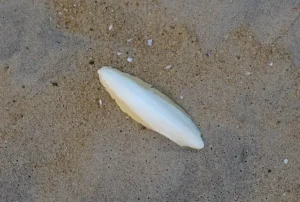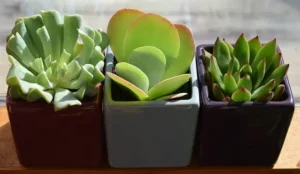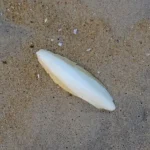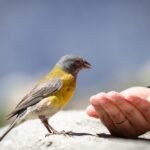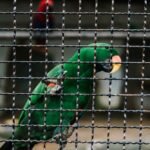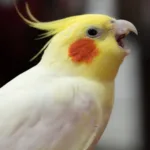Geophagy or the practice of eating dirt is prevalent in many animals. In the avian world, this practice is seen in a few species of birds, but most commonly parrots.
Flocks of parrots gather seasonally on clay licks to feed on the mineral-enriched soil. Clay licks are soil deposits situated near a riverbank. They are created by the erosion of rocks over long periods.
The practice of clay eating by parrots has puzzled ornithologists and scientists for years. After years of research, there have been numerous theories and discoveries around the purpose of clay licks.
Wild parrots eat clay to neutralize the toxins they ingest from unripe fruits, raw nuts, and other toxic foods in the forest. Clay licks also provide parrots with sodium which is a scarce mineral in their natural habitat. Studies also show that more parrots visit clay licks in the breeding seasons due to their increased nutritional needs.
Quick Navigation
Reasons Why Parrots Eat Clay
Seasonally, large flocks of parrots visit the numerous clay licks scattered throughout the Amazon Rainforest. They collect on these areas and peck at the hardened soil. However, there are still many unanswered questions related to the purpose of clay licks for parrots.
There are several theories that explain why parrots visit clay licks and what purposes they serve for them. There have been numerous studies on geophagy that show certain important functions such as enhancement of digestion, toxin absorption, sodium supplementation, and gastrointestinal protection.
Neutralizing Dietary Toxins
Parrots don’t inherently know what is safe for them to eat and what is not. In the wild, they fulfill their dietary needs by any means necessary, whether it means eating toxic nuts from the trees or poisonous insects from the ground.
As found in a study conducted by PLOS ONE, parrots eat a diversity of foods even in seasons when food is scarce. They are not very selective when it comes to choosing food.
An example of this could be the raw nuts and seeds that parrots eat in the wild. Raw nuts often contain bacteria and toxins in them. Yet, parrots are able to eat them without being affected by the toxic effects.
A study published by Springer Link shows that geophagy helps parrots neutralize toxins in the food they eat. In an experiment conducted on captive Amazona parrots clay was orally administered to study the effects of a toxic substance called quinidine.
It was found that the clay ingested by parrots reduced the effectiveness of the toxin by 60%, thereby demonstrating that eating clay helps absorb toxins. It was also noted that the clay stayed in the parrots’ digestive systems for more than 12 hours, which suggested it could help protect their stomach and intestines from damage.
Clay is like an antidote to all the toxins parrots ingest every day. And it is not just plant-based- foods, but also certain toxic insects that they come across while foraging in the grass.
Sodium Supplementation
Some people theorized that parrots could be eating clay to supplement their diet with certain minerals. However, it has been found that clay licks offer little mineral supplementation outside of what a parrot is already able to obtain from its regular diet in the rainforests.
Another theory suggests that parrots eat clay to up their sodium intake. Due to the low sodium availability in the rainforests, parrots are unable to get it in sufficient amounts. Even though parrots need very low amounts of sodium, its low availability in their habitat and abundance of potassium in their diet could be driving this behavior.
Parrots mostly eat a frugivorous diet in the forests that consists of fruits, nuts, and seeds. This often leads to an imbalance of electrolytes as potassium is more widely available than sodium.
In a study conducted by BioTropica researchers looked at 22 soil samples from clay licks that macaws and other parrots visited. They found that the soil in those areas had much more sodium than the plants parrots consumed in the rainforests. This points to the fact that parrots might be eating soil to get enough sodium in their diet.
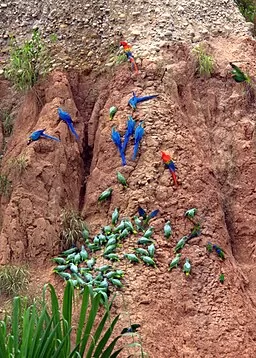
Nutritional Demands During Breeding Season
A study by the International Journal Of Avian Science tried to understand the relationship between when parrots engaged in geophagy the most and the commonly hypothesized drivers of this behavior.
The two common explanations for avian geophagy are protection against toxins and higher nutritional demands during the breeding season. The study hypothesized if parrots ate clay to protect themselves against toxins, geophagy would be highest when food availability is low as the parrots will be forced to eat foods that are toxic.
Similarly, if this behavior is driven by nutritional needs, geophagy should be highest during the breeding season. The researchers found that geophagy in parrots peaked during breeding seasons.
This is because a parrot’s nutritional needs are higher during this season. Female parrots that are carrying eggs need more calcium to form stronger egg shells. Also, once the chicks hatch from the eggs, parrots need to provide for them. There is also an increase in food intake due to increased energy requirements for building nests and taking care of the young ones.
Should You Include Clay Supplement To Your Parrot’s Diet?
You can provide a clay supplement to your parrot, but it should be consumed in moderation. In the wild parrots lack sodium in their diet due to natural reasons which drives them to clay licks.
However, a captive parrot’s diet is much different and they often do not require additional supplements. In fact, ingesting sodium in excess can lead to salt toxicosis in parrots. So you need to be careful while adding additional sodium in your parrot’s diet.
Using clay supplements can be a healthy addition to your parrot’s diet when it is fed in the appropriate amounts. Salt or clay blocks contain some important minerals and nutrients that parrots need. Let’s take a look at some of the benefits of clay supplements for parrots:
High In Calcium
Calcium is an important nutrient in a parrot’s diet, especially for female parrots. It helps in the formation of strong eggshells. If a female parrot is deficient in calcium it can lead to problems like egg-binding, thin egg shells, and other health-related issues. Calcium deficiency is more common in parrots that are on a seed-based diet.
Natural Detox
Although we may think that we are feeding our parrots healthy, many whole foods such as vegetables and seeds are laden with pesticides and other chemicals. Also, many human foods that we feed our birds contain preservatives and additives that are harmful to them. Clay can help parrots expel these toxins from their body and also protect their digestive health.
How To Give Clay Supplement To Your Parrot?
Bentonite or Montmorillonite is a clay commonly used as a supplement for parrots. It is available in powered and brick form. Here are some ways you can offer clay to your parrot:
Sprinkled On Top Of Food
Bentonite is also available in the form of powder, which can be easily sprinkled or mixed into your parrot’s meals. It is a better way to supplement your parrot’s diet since you are able to control how much your parrot eats.
Clay Blocks
Clay blocks are also a great foraging item for your parrot. Parrots love their food hidden in their surroundings. However, the only problem with this is that you cannot track how much your parrot eats at one time. Although clay blocks are not extremely high in sodium, you do need to monitor their intake.

